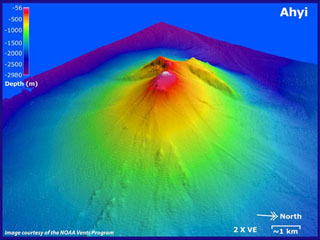Report on Ahyi (United States) — 23 April-29 April 2014
Smithsonian Institution / US Geological Survey
Weekly Volcanic Activity Report, 23 April-29 April 2014
Managing Editor: Sally Sennert.
Please cite this report as:
Global Volcanism Program, 2014. Report on Ahyi (United States) (Sennert, S, ed.). Weekly Volcanic Activity Report, 23 April-29 April 2014. Smithsonian Institution and US Geological Survey.
Ahyi
United States
20.42°N, 145.03°E; summit elev. -75 m
All times are local (unless otherwise noted)
Seismic stations on Pagan, Sarigan, Anatahan, and Saipan began recording signals starting at 0635 on 24 April believed to be from an undersea volcanic source. Hydroacoustic sensors on Wake Island suggested that the source is at or near Ahyi seamount, although it was possible that the vent is located at one of the other volcanic seamounts in the area. While conducting coral reef research at Farallon de Pajaros, NOAA divers reported hearing loud explosions and feeling the shock waves. One of the more powerful explosions was felt by the crew as it reverberated through the hull of the ship. On 27 April the Color Code was raised from Unassigned to Yellow. A report issued at 0536 on 30 April noted that seismic activity remained high.
Geological Summary. Ahyi seamount is a large conical submarine volcano that rises to within 75 m of the ocean surface ~18 km SE of the island of Farallon de Pajaros in the northern Marianas. Water discoloration has been observed there, and in 1979 the crew of a fishing boat felt shocks over the summit area, followed by upwelling of sulfur-bearing water. On 24-25 April 2001 an explosive eruption was detected seismically by a station on Rangiroa Atoll, Tuamotu Archipelago. The event was well constrained (+/- 15 km) at a location near the southern base of Ahyi. An eruption in April-May 2014 was detected by NOAA divers, hydroacoustic sensors, and seismic stations.
Sources: Emergency Management Office of the Commonwealth of the Mariana Islands and United States Geological Survey Volcano Hazards Program, Bill Chadwick, Oregon State University's Marine Science Center and NOAA/PMEL EOI Program, personal communication

